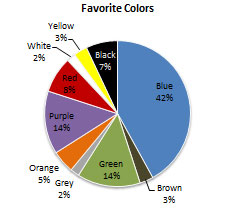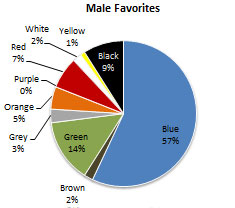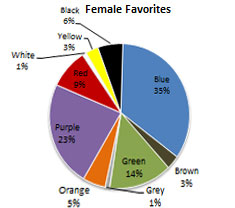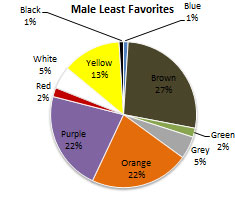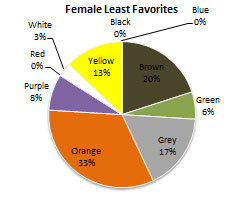The Hidden Language of Color 
Hey, what's your favorite color? If you're a guy, I'll bet you said "blue." (57% of the male population does). If you're a lady, blue's still a popular favorite but there's a pretty good chance you favor purple instead.
However, the more important question is: why is there such a thing as a favorite color in the first place? What is color after all? Scientifically, it's just thin slice out of the electromagnetic spectrum (wavelengths between 380 and 740 nanometers to be precise...)
The answer is of course that we all have emotional reactions to various colors. We form associations based on color, and we've learned to communicate using color.
Next question: What color car do you drive?
Assuming you chose the color, that choice probably reflects something about you and your personality. According to Leatrice Eiseman (a nationally renowned color consultant) and the DuPont Automotive Color Popularity Report, here's what your car color says about you:

Silver |
Elegant, loves futuristic looks, cool |

Dark Green |
Traditional,
trustworthy, well-balanced |

White |
Fastidious |

Bright Yellow-Green |
Trendy,
whimsical, lively |

Vibrant Red |
Sexy,
speedy, high-energy and dynamic |

Yellow Gold |
Intelligent,
warm, loves comfort and will pay for it |

Light to Mid-Blue |
Cool,
calm, faithful, quiet |

Sunshine Yellow |
Sunny
disposition, joyful and young at heart |

Dark Blue |
Credible,
confident, dependable |

Deep Brown |
Down-to-earth,
no-nonsense |

Taupe / Light Brown |
Timeless,
basic and simple tastes |

Orange |
Fun
loving, talkative, fickle and trendy |

Black |
Empowered,
not easily manipulated, loves elegance, appreciates classics |

Deep Purple |
Creative, individualistic, original |

Neutral Gray |
Sober,
corporate, practical, pragmatic |
|
|
I can't guarantee the above profile will fit you exactly, but isn't it interesting that a simple choice of hue can potentially communicate so much?
Favorite and Least Favorite Colors
Returning to the topic of favorites, here is a breakdown of votes by both men and women for "most preferred color:"
What Do Various Colors Communicate?
|
About the Color |
Positive Connotations |
Negative Connotations |
Cultural Distinctions |

Red |
Bright red evokes strong emotions, both positive and negative. Red can even have a physical effect on people, increasing rate of respiration and raising blood pressure. |
Excitement, energy, passion, love, desire, speed, strength, power, heat. |
aggression, blood, danger, fire, war, violence, communism, the Devil. |
Happiness, purity, joy, celebration (Eastern cultures)
Mourning (South Africa) |

Green |
Green symbolizes nature and the natural world (of course). It is also strongly associated with money and luck. |
Nature, the environment, growth, healthfulness, good luck, tranquility, renewal, youth, springtime, generosity, fertility, vigor. |
Envy, jealousy, inexperience, misfortune. |
In 15th century Europe, many brides wore green wedding gowns, as a symbol of fertility. |

Blue |
Most preferred of all the colors, blue often invokes feelings of calm and serenity. Blue is associated with many positive connotations and is also a "natural" color (blue sky, water, etc.) |
Peace, tranquility, calm, stability, harmony, unity, trust, truth, confidence, conservatism, security, cleanliness, order, loyalty, sky, water. |
Depression ("feeling blue"), sadness, coldness, and aloofness. Blue tableware can curb appetite. Few foods are naturally blue, and we may have developed primitive associations that blue indicates spoilage or poison. |
In many primitive cultures, blue is believed to ward off bad spirits. It is important in religious beliefs, and is frequently associated with peace and stability. |

Cyan |
Variations of cyan (a mixture of blue and green) are known as turquoise, aqua, and ultramarine. A darker shade is called teal. |
Calm, water, refreshing. |
I couldn't find any negative connotations. |
Turquoise (the mineral) is treasured by native Americans in the southwest. |

Yellow |
Bright yellow is very attention-getting. However, that same brightness can make it fatiguing and tiresome. Of all the pure hues, yellow is most evocative of precious gold. |
Happiness, joy, optimism, idealism, hope ("yellow ribbon"), imagination, sunshine, summertime. |
Betrayal, dishonesty, cowardice, jealousy, covetousness, deceit, frustration, anger, illness.
Hazard (warning signs, etc.). |
Yellow is a color of mourning in Egypt. It represents courage in Japan. |

Orange |
Vibrant and warm, orange shares certain characteristics from its "parent" colors red and yellow. |
Energy, warmth, balance, enthusiasm, flamboyant, vibrance. |
I couldn't find any formal negative connotations, but many people simply don't like orange. |
Orange is a "summer color," but is also associated with the fall season. |

Brown |
Brown is a natural color of the earth. It's also a "down to earth" color, somewhat neutral but warm. |
Earth, stability, hearth/warmth, home, wholesomeness, outdoors, comfort, endurance, simplicity, comfort, reliability. |
Sadness, isolation, decay. |
Brown is considered a fall and winter color. It's also viewed as a "sophisticated" color (but less so than black). Brown tableware is an appetite stimulant. |

Tan |
Tan/Beige is neutral, bridging between warm brown and cool white. |
Calm, quiet, pleasant, simple, understated. |
Dull, boring. |
A conservative color, tan is sometimes used for religious garments. |

Purple
|
The color of royalty, purple is strongly associated with wealth, particularly when combined with the color gold. |
Royalty, nobility, wisdom, spirituality, ceremony, mystery, transformation, enlightenment. |
Cruelty, arrogance, mourning. |
Rare in nature, purple can therefore have the connotation of being exotic or even artificial. |

Pink |
Strongly associated with love and romance. However, pink is also a "controversial" color. |
Love, romance, excitement, femininity, playfulness. |
"Little girl" (derogatory), effeminate. |
Some sports teams paint the opposing team's visiting locker room pink to "weaken" them. |

Lavender |
Described as a "grown up pink," lavender is less overt and cliche when used by or for women. |
Grace, elegance, femininity, refinement, nostalgia. |
None I could find. |
Found in exotic flowers like orchids, lavender may be thought of as delicate and precious. |

White |
White can be viewed as the total absence of color or the sum of all colors (which it is). White harmonizes with everything. |
Cleanliness, purity, simplicity, peace, humility, precision, innocence, youth, winter. |
Sterile, cold, bland, unfriendly, clinical. |
While white is associated with marriage in Western cultures, it is the color of death in many Eastern ones. |

Gray
|
Gray is a cool, neutral, middle-of-the-road color that goes well with many other hues. |
Security, reliability, intelligence, modesty, dignity, formality, maturity, solid, conservative, practical. |
Old age, sadness, boring, stormy (clouds). |
Gray is a formal, sophisticated color that could also be associated with mourning. In attire, it's part of the western business "uniform." |

Black |
Even though it is undisputedly the absence of all light and color, black is emotionally-charged to a great degree. It is strongly associated with both positive and negative traits. |
Power, sexuality, sophistication, formality, elegance, wealth, mystery, depth, style. |
Fear, menace, evil, unhappiness, sadness, remorse, anger, anonymity, hiding. |
Black symbolizes mourning and death in most Western cultures. Symbol of rebellion by youth and "black hat" bad guy behavior. |
The Temperature of Color
Another way of thinking about the psychological effects of various colors is by dividing them into cool, warm, and neutral categories:
| Cool |
Warm |
Neutral |
Blue
Purple
Green
Cyan |
Red
Orange
Yellow
Brown
Pink/Lavender |
White
Gray
Black
Tan |
In general, cool colors are associated with calm but also melancholy, discomfort, and indifference. Warm colors may evoke emotions ranging from warmth and well-being to aggression, anger, and hostility. Neutrals may either straddle the temperature scales or serve to intensify their effect (i.e. bright yellow on a black background seems much brighter than it would be absent that context.)
Choosing Colors to Achieve an Effect
I think it's fairly safe to say that most of us would like to be viewed as trustworthy. Trust is a valuable commodity, particularly in today's skeptical society. It's therefore worthwhile to go back to the Hallock survey to analyze which colors are considered most trustworthy:
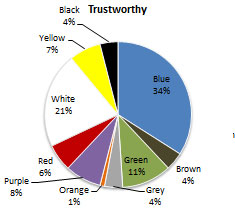 |
Blue ranks highest. No surprise that so many corporations, banks, and other financial institutions have one or more shades of blue in their logos. White also connotes trustworthiness. All the other colors trail far behind. |
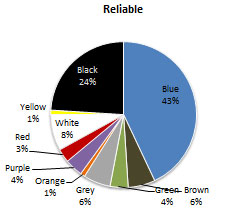 |
Another highly desirable trait in both products and people is reliability. Blue ranks highest again, by a large margin, followed by black. All other colors are "thin slice." |
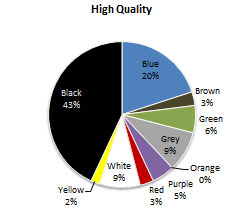 |
When people were asked which color best represents "high quality," black surpassed blue to become the top pick by far. People most likely associated this question with a "product" rather than a person. It's interesting to consider the inverse of high quality (i.e. shoddy and cheap). Viewing their low percentages, orange, yellow, red, and brown are most strongly associated with those negative characteristics (at least in this context). |
Wrap Up
This has turned into a rather long article, so if you made it this far, thank you! I hope your effort in reading it will result in a deeper understanding of our colorful world. I also hope it will help you make better and more strategic color choices in your work and your life.

Return to Archive |


